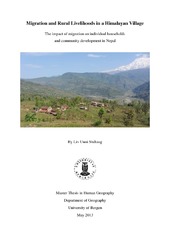| dc.description.abstract | In developing countries it has increasingly been recognised how rural households draw upon a range of assets and activities to form viable livelihoods. In Nepal as well as in other parts of the world involvement in migration has been an important strategy of rural households to support their living. This thesis presents an idiographic study focused on how the incorporation of migration in rural livelihood strategies affects households' abilities to form viable livelihoods in the village of Astam, Nepal. Furthermore, it discusses to what extent migration can contribute to local development. The analytical frameworks applied are theoretical approaches to rural livelihoods with emphasis on various forms of capital, as well as a perspective of contextualised interactions between migration and development. It is concluded that the capital concepts utilised in livelihood approaches in some cases tend to ignore the economic logic inherent in capital', and that Bourdieu's notion of capital can be appropriate for analyses of rural livelihoods. The qualitative methods of participant observation and in-depth interviews were used to produce empirical data, complemented by a survey (=50) of the village's households in order to map involvement in migration and other characteristics of their livelihood strategies. From this I found that internal and external migration are widely incorporated in households' livelihood strategies in Astam and can be a vital source of cash income in the rural context of limited economic opportunities. Although incomes from migration are in most cases spent on consumption I will argue that this should not simply be termed as unproductive investments' if we assume an understanding of development' as the enhancement of freedoms for all. An interesting finding from this study is that the migrants who have been able to initiate an accumulation of capital from migration in some cases have invested parts of this capital in community projects which have improved the poorer households' access to facilities of health care and education in particular. This may also allow poor households to further enhance their bases of capital. Thereby, even though migration to some extent may increase inequality between migrant households and no-migrant households in the village, in some cases the individual households' gains from migration are also redistributed in the community to the benefit of a larger segment of villagers. | en_US |
